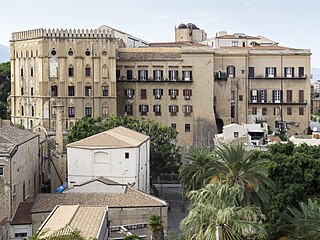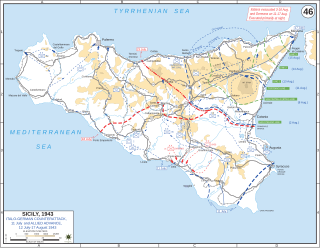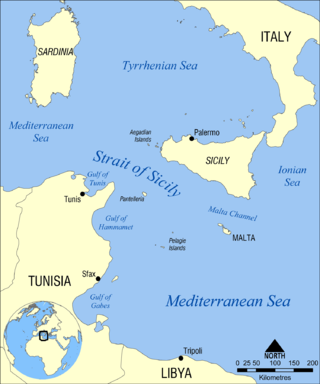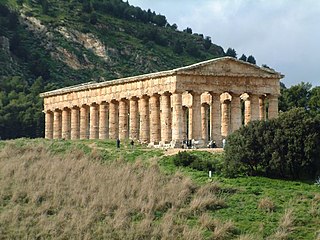
Sicily is an island in the central Mediterranean Sea, south of the Italian Peninsula in continental Europe and is one of the 20 regions of Italy. With 4.8 million inhabitants, including 1.3 million in and around the capital city of Palermo, it is the most populous island in the Mediterranean Sea. It is named after the Sicels, who inhabited the eastern part of the island during the Iron Age. Sicily has a rich and unique culture in arts, music, literature, cuisine, and architecture. Its most prominent landmark is Mount Etna, the tallest active volcano in Europe, and one of the most active in the world, currently 3,357 m (11,014 ft) high. The island has a typical Mediterranean climate. It is separated from Calabria by the Strait of Messina. It is one of the five Italian autonomous regions and is generally considered part of Southern Italy.

Palermo is a city in southern Italy, the capital of both the autonomous region of Sicily and the Metropolitan City of Palermo, the city's surrounding metropolitan province. The city is noted for its history, culture, architecture and gastronomy, playing an important role throughout much of its existence; it is over 2,700 years old. Palermo is in the northwest of the island of Sicily, by the Gulf of Palermo in the Tyrrhenian Sea.

Cannoli are a Sicilian pastry consisting of a tube-shaped shell of fried pastry dough, filled with a sweet, creamy filling containing ricotta cheese. Its size ranges from 9 to 20 centimetres. In mainland Italy, it is commonly known as cannolo siciliano.

The Allied invasion of Sicily, also known as the Battle of Sicily and Operation Husky, was a major campaign of World War II in which the Allied forces invaded the island of Sicily in July 1943 and took it from the Axis powers. It began with a large amphibious and airborne operation, followed by a six-week land campaign, and initiated the Italian campaign.
An emirate is a territory ruled by an emir, a title used by monarchs or high officeholders in the Muslim world. From a historical point of view, an emirate is a political-religious unit smaller than a caliphate. It can be considered equivalent to a principality in non-Muslim contexts.

The Kingdom of Sicily was a state that existed in Sicily and the south of the Italian Peninsula plus, for a time, in Northern Africa from its founding by Roger II of Sicily in 1130 until 1816. It was a successor state of the County of Sicily, which had been founded in 1071 during the Norman conquest of the southern peninsula. The island was divided into three regions: Val di Mazara, Val Demone and Val di Noto.

Southern Italy, also known as Meridione or Mezzogiorno, is a macroregion of Italy consisting of its southern regions.

The Sicilians, or Sicilian people, are a Romance-speaking European ethnic group who are indigenous to the island of Sicily, the largest island in the Mediterranean, as well as the largest and most populous of the autonomous regions of Italy.

The Strait of Sicily is the strait between Sicily and Tunisia. The strait is about 145 kilometres (90 mi) wide and divides the Tyrrhenian Sea and the western Mediterranean Sea, from the eastern Mediterranean Sea. The maximum depth is 316 meters (1,037 ft). The island of Pantelleria lies in the middle of the strait.

The province of Syracuse was a province in the autonomous island region of Sicily, Italy. Its capital was the city of Syracuse, a town established by Greek colonists arriving from Corinth in the 8th century BC. It had an area of 2,109 square kilometres (814 sq mi) and a total population of 403,985 (2016). Syracuse had 8% of the Sicilian population and 8.2% of Sicily's area.

Arancini, also known as arancine, are Italian rice balls that are stuffed, coated with breadcrumbs and deep-fried. They are a staple of Sicilian cuisine. The most common arancini fillings are al ragù or al sugo, filled with ragù, mozzarella or caciocavallo cheese, and often peas, and al burro or ô burru, filled with prosciutto and mozzarella or béchamel sauce.

Val di Noto is a historical and geographical area encompassing the south-eastern third of Sicily; it is dominated by the limestone Hyblaean plateau. Historically, it was one of the three valli of Sicily.

Augusta is a town and comune in the province of Syracuse, located on the eastern coast of Sicily. The city is one of the main harbours in Italy, especially for oil refineries which are in its vicinity.

The history of Sicily has been influenced by numerous ethnic groups. It has seen Sicily controlled by powers, including Phoenician and Carthaginian, Greek, Roman, Vandal and Ostrogoth, Byzantine, Arab, Norman, Aragonese, Spanish, Austrians, British, but also experiencing important periods of independence, as under the indigenous Sicanians, Elymians, Sicels, the Greek-Siceliotes, and later as County of Sicily, and Kingdom of Sicily. The Kingdom was founded in 1130 by Roger II, belonging to the Siculo-Norman family of Hauteville. During this period, Sicily was prosperous and politically powerful, becoming one of the wealthiest states in all of Europe. As a result of the dynastic succession, the Kingdom passed into the hands of the Hohenstaufen. At the end of the 13th century, with the War of the Sicilian Vespers between the crowns of Anjou and Aragon, the island passed to the latter. In the following centuries the Kingdom entered into the personal union with the Spaniard and Bourbon crowns, while preserving effective independence until 1816. Sicily was merged with the Kingdom of Italy in 1861. Although today an Autonomous Region, with special statute, of the Republic of Italy, it has its own distinct culture.

The Muslim conquest of Sicily began in June 827 and lasted until 902, when the last major Byzantine stronghold on the island, Taormina, fell. Isolated fortresses remained in Byzantine hands until 965, but the island was henceforth under Muslim rule until conquered in turn by the Normans in the 11th century.

The 1693 Sicily earthquake struck parts of southern Italy near Sicily, then a territory part of the Crown of Aragon by the Kings of Spain Calabria, and Malta on 11 January at around 21:00 local time. This earthquake was preceded by a damaging foreshock on 9 January. The main quake had an estimated magnitude of 7.4 on the moment magnitude scale, the most powerful in Italian recorded history, and a maximum intensity of XI (Extreme) on the Mercalli intensity scale, destroying at least 70 towns and cities, seriously affecting an area of 5,600 square kilometres (2,200 sq mi) and causing the death of about 60,000 people.

Akrai was a Greek colony of Magna Graecia founded in Sicily by the Syracusans in 663 BC. It was located near the modern Palazzolo Acreide.

The Italo-Albanian Catholic Church or Italo-Albanian Byzantine-Catholic Church is one of the 23 Eastern Catholic Churches which, together with the Latin Church, compose the Catholic Church. It is an autonomous (sui juris) particular church in full communion with the Pope of Rome, directly subject to the Roman Dicastery for the Oriental Churches, but which follows the Byzantine Rite, the ritual and spiritual traditions that are common in most of the Eastern Orthodox Church. It uses two liturgical languages: Koine Greek, the traditional language of the Eastern Churches, and Albanian, the native language of most of its adherents.
The 1169 Sicily earthquake occurred on 4 February 1169 at 08:00 local time on the eve of the feast of St. Agatha of Sicily. It had an estimated magnitude of between 6.4 and 7.3 and an estimated maximum perceived intensity of X (Extreme) on the Mercalli intensity scale. The cities of Catania, Lentini and Modica were severely damaged, and the earthquake also triggered a paleotsunami. Overall, the earthquake is estimated to have caused the deaths of at least 15,000 people.

Ophrys holosericea, the late spider orchid, is a species of flowering plant in the family Orchidaceae, native to western and central Europe and the Mediterranean region. There has been considerable confusion about the identity of this species and the correct spelling of its name.


















